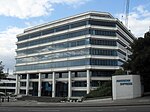Carlton Hill is an inner-city area of Brighton, part of the English city and seaside resort of Brighton and Hove. First developed in the early and mid-19th century on steeply sloping farmland east of central Brighton, it grew rapidly as the town became a fashionable, high-class destination. Carlton Hill's population was always poor, though, and by the early 20th century the area was Brighton's worst slum: overcrowding, crime and disease were rife. Extensive slum clearance in the mid-20th century introduced high-density tower blocks, but some old buildings remain: in 2008, Brighton and Hove City Council designated part of Carlton Hill as the city's 34th conservation area. The area now has housing of various styles and ages, large offices and small-scale industry; there are also churches, a school and some open space.
Carlton Hill's pattern of development was defined by the long-established structure of land ownership around Brighton, whereby land was divided into long, narrow strips with many different owners. This encouraged the development of terraced housing—the predominant housing pattern until the council undertook large-scale demolition and high-density rebuilding in the mid-20th century. This work introduced more open space and varied land uses: Brighton Art College was able to expand into the area, and American Express opened a large, visually dominant headquarters.
Buildings lost during the 20th century include schools and several chapels serving various Christian denominations. The former St John the Evangelist's Anglican church was declared redundant and sold to Brighton's Greek Orthodox community; meanwhile, a distinctive Modernist church was built in the 1960s for Spiritualists. A cluster of historic early 19th-century houses and other structures survived the redevelopment, and several were awarded listed status by English Heritage. These buildings and their surroundings were afforded further protection in 2008 when the city council designated the Carlton Hill conservation area.












